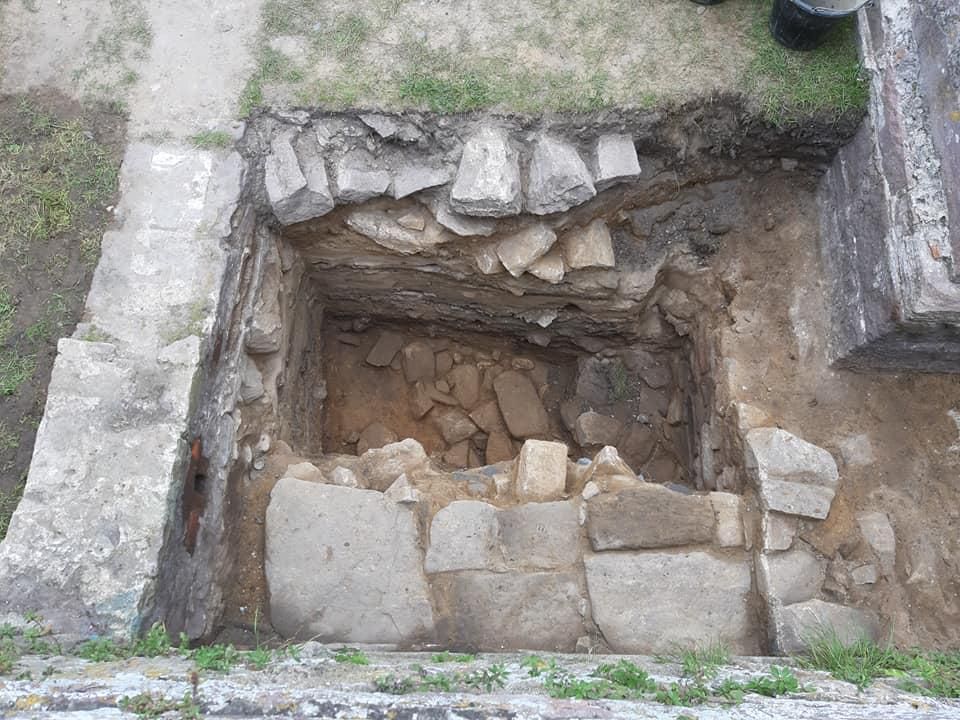World War II Bunker Discovered Inside Ruins of Roman Fort
Nazi soldiers built the shelter during the German occupation of Alderney, an island in the English Channel
:focal(754x493:755x494)/https://tf-cmsv2-smithsonianmag-media.s3.amazonaws.com/filer/d1/64/d164d910-4d6b-4463-84c1-352db7aa696d/240655780_2908324266074474_8727985573604200927_n.jpeg)
Excavations on the Channel Island of Alderney have revealed a Nazi bunker built within the ruins of the Nunnery, one of the most well-preserved Roman forts in the British Isles, reports BBC News.
German soldiers created the shelter during the Nazi occupation of the Channel Islands, an archipelago off the coast of Normandy, France. Spanning June 1940 to May 1945, the occupation represented Germany’s only successful seizure of British territory during World War II.
Archaeologist Jason Monaghan tells BBC News that Nazi troops placed the newly unearthed fortification “exactly inside” the Nunnery’s ten-foot-thick walls. Volunteers from Dig Alderney, a charity organization that supports archaeological research on the island, aided this summer’s excavations.
“[We found a] whole succession of buildings, drains and mystery walls intersecting each other,” Monaghan says, adding that the team has “just come across three floors all on top of each other and [is] trying to disentangle what eras they come from.”
Overlooking Longis Bay, the Nunnery has been in almost continuous use for some 1,700 years, reports Aaron Carpenter for the Bailiwick Express. Writing for Current Archaeology in 2011, Monaghan noted that the Romans built the military outpost toward the end of the fourth century C.E., when imperial control over Britain was weakening. They equipped the fort with state-of-the-art defensive mechanisms, including battlement crenellations.
Excavations at the site began in the 1930s but failed to provide definitive proof of the fort’s age until recently, as BBC News reported in 2011. At the time, Monaghan and his colleagues had just identified the ruins of a tower in the middle of the fort, as well as Roman-era walls and a gateway.
“The … beautiful thing about [the Nunnery] is that it is very small and very easy to understand,” Monaghan told BBC News in 2011. “A lot of archaeological sites you go there and you actually need a PhD to understand what's going on. But the Nunnery you can understand—it’s a fort, it’s guarding the bay, it’s got walls, it’s got towers, you can very easily get your head around it.”
Locals repaired damage to the fort’s Roman-era walls, in addition to constructing a number of new buildings, during the late medieval period, when the site served as the governor of Alderney’s residence. Per the Bailiwick Express, the British Army demolished many of these Tudor-era constructions in 1793, replacing them with barracks and other military buildings.
In addition to excavating the Nazi bunker, the Dig Alderney team investigated the “sun room”—one of the only areas of the fort left untouched during the German occupation, notes Richard Heath for the Jersey Evening Post. This section was thought to hold clues to the site’s history following the Romans’ departure. Other areas of interest included a square building likely dated to the Victorian period and a “mystery” structure depicted as a ruin on a 1739 map.
“Around 1906 the buildings were converted for use by military families and the earlier ramparts buried. [Then] the Germans extensively refortified the site … during the occupation,” Monaghan tells the Bailiwick Express. “Add a multitude of drains and 20th-century utilities and there is a lot to pick apart beneath the surface. We do not know if it was ever, in fact, a nunnery.”
During World War II, the Germans transformed Alderney into a heavily fortified base boasting bunkers, anti-tank walls and tunnels. Sylt, one of two Nazi concentration camps on the evacuated island, was largely forgotten after the war, but last year, research published in the journal Antiquity offered new insights on the camp’s development, as well as the torturous treatment endured by its prisoners.
/https://tf-cmsv2-smithsonianmag-media.s3.amazonaws.com/accounts/headshot/Isis_Davis-Marks_thumbnail.png)


/https://tf-cmsv2-smithsonianmag-media.s3.amazonaws.com/filer/f3/50/f350292a-478e-4e76-8c86-b50fc6789677/_119648952_capturesdfsd.jpeg)
/https://tf-cmsv2-smithsonianmag-media.s3.amazonaws.com/accounts/headshot/Isis_Davis-Marks_thumbnail.png)